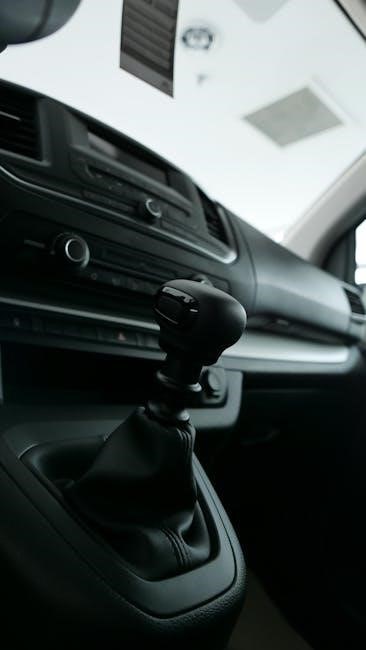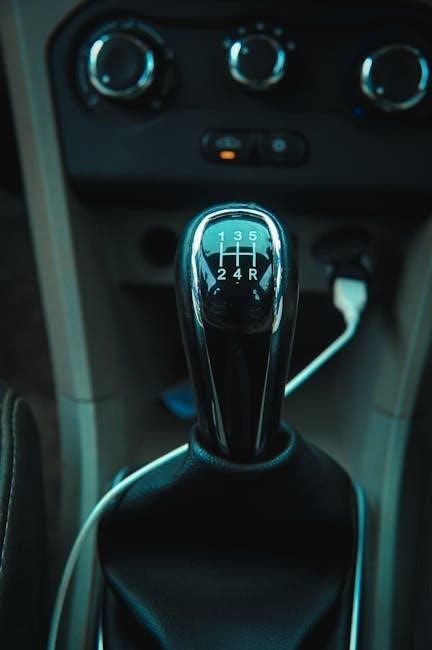volvo with manual transmission
Volvo’s manual transmissions offer precise control and driving engagement, featured in classic models like the V70 and modern options, appealing to enthusiasts who value performance and efficiency.
1.1 Overview of Volvo’s History with Manual Transmissions
Volvo’s history with manual transmissions dates back to its early models, emphasizing durability and performance. The 2003 Volvo V70 wagon, for instance, featured a 5-speed manual transmission, showcasing the brand’s commitment to driver engagement. Historically, manual transmissions were common in Volvo’s lineup, particularly in European markets, where they were often paired with non-turbocharged engines. The M90 gearbox, introduced in 1994 for the Volvo 940/960, exemplifies the brand’s focus on robust, reliable manual transmissions. Over the years, Volvo has balanced tradition with innovation, offering manual options in select models while adapting to industry trends. This legacy continues to appeal to enthusiasts who value the precision and control of manual driving.
1.2 Importance of Manual Transmissions in Volvo’s Lineup
Manual transmissions have long been a cornerstone of Volvo’s lineup, offering drivers precise control and a more engaging driving experience. These transmissions, featured in models like the V70 and C30, cater to enthusiasts who value the connection between driver and vehicle. The Geartronic transmission, combining manual-like control with automatic convenience, further highlights Volvo’s commitment to versatility. Manual transmissions also appeal to a niche market, ensuring Volvo maintains its reputation for performance and driver-centric design. Despite industry trends favoring automatics, Volvo’s manual options remain a testament to its heritage and dedication to driving purists. This focus on manual transmissions underscores Volvo’s balance between tradition and innovation, appealing to both classic enthusiasts and modern eco-conscious drivers seeking efficiency;

Volvo Models with Manual Transmission
Volvo’s lineup includes models like the V70, C30, and XC40, offering manual transmissions that appeal to driving enthusiasts seeking control and a connected driving experience.
2.1 Classic Volvo Models Featuring Manual Transmissions
Classic Volvo models like the 2003 V70 wagon and earlier 940/960 series showcased robust manual transmissions, offering drivers precise control and a connected driving experience. These models, often preferred by enthusiasts, combined durability with performance, making them iconic choices for those who valued hands-on driving. The M90 rear-wheel-drive gearbox in the 940/960 exemplified Volvo’s commitment to manual transmissions, providing smooth shifting and reliability. These classic cars remain popular among collectors and purists who appreciate the tactile engagement of a manual gearbox. Their enduring appeal highlights Volvo’s heritage in delivering driver-focused vehicles with a balance of practicality and performance.
2.2 Modern Volvo Models with Manual Transmission Options
While Volvo has largely shifted focus to automatic transmissions, select modern models still offer manual options, catering to driving enthusiasts. The V60 Cross Country and XC40 B3 Mild Hybrid are examples where manual transmissions remain available, blending efficiency with driver engagement. Volvo’s Geartronic dual-clutch automatic, though not a traditional manual, provides manual shifting modes, appealing to those who enjoy control. Recent innovations like start/stop technology, paired with Geartronic, enhance fuel efficiency without sacrificing performance. These modern models demonstrate Volvo’s balance between tradition and innovation, ensuring manual transmission fans still have options. However, the availability of manual transmissions in Volvo’s lineup continues to diminish as the brand prioritizes automatic and electric powertrains.
Performance and Handling

Manual transmissions in Volvo enhance driving dynamics, offering precise control and a direct connection to the vehicle. They optimize acceleration and responsiveness, delivering a more engaging driving experience.
3.1 Driving Dynamics with Manual Transmission
Volvo’s manual transmissions deliver a more immersive driving experience, offering precise control and a direct connection to the vehicle. Classic models like the V70 and C30, equipped with manual gearboxes, provide enthusiasts with a tactile driving engagement that modern automatics often lack. The manual transmission allows drivers to optimize gear shifts according to their driving style, enhancing both performance and efficiency. For instance, the M90 gearbox in older Volvo models is renowned for its smooth, mechanical feel, making it a favorite among purists. Even in modern Volvos, where manual options are less common, the availability of such transmissions caters to a niche market of drivers who value the emotional and functional benefits of shifting gears manually.
3.2 Acceleration and Speed Capabilities
Volvo models with manual transmissions are known for their balanced blend of acceleration and speed, catering to both everyday driving and spirited performance. The manual gearbox allows drivers to optimize gear shifts, maximizing torque delivery and responsiveness. For instance, the Volvo V70 with a 5-speed manual transmission offers smooth acceleration, making it suitable for both city commutes and highway cruising. Similarly, the C30 and XC90 models with manual options provide a sporty feel while maintaining Volvo’s reputation for safety and reliability. These vehicles deliver consistent power delivery, ensuring a seamless driving experience. The combination of precise shifting and Volvo’s engineered performance capabilities makes manual transmission models a compelling choice for drivers seeking both efficiency and driving enjoyment.
Decline of Manual Transmissions in Modern Cars
Manual transmissions are becoming rare as automakers prioritize efficiency, emissions, and market appeal. Volvo, like others, has shifted focus to automatics and CVTs, reflecting industry trends.
4.1 Industry Trends and Shift to Automatic Transmissions

The automotive industry has seen a significant decline in manual transmissions as automakers increasingly favor automatic, CVT, and dual-clutch transmissions. These alternatives offer improved efficiency, smoother operation, and reduced driver effort, aligning with modern consumer preferences for convenience and technology. Volvo, like many manufacturers, has embraced this trend, integrating advanced automatic transmissions across its lineup to meet stringent emissions standards and enhance fuel economy. The shift reflects broader industry priorities, where automatics are perceived as better suited for urban driving and reducing driver fatigue. This transition has been accelerated by advancements in transmission technology, making automatics more refined and efficient than ever before.
4.2 Volvo’s Approach to Maintaining Manual Options
Volvo has historically catered to driving enthusiasts by offering manual transmissions in select models, particularly in European markets. While the industry shifts toward automatics, Volvo continues to provide manual options in certain trim levels, emphasizing driver engagement. The Geartronic transmission, combining manual control with automatic convenience, reflects Volvo’s innovative approach. Limited production of manual models ensures they remain exclusive, appealing to purists. This strategy balances market demands with niche preferences, preserving the manual tradition for loyal customers who value precision and control behind the wheel.

Reliability and Maintenance
Volvo’s manual transmissions are known for durability, but issues like worn synchros and AGR valve failures can arise. Regular fluid changes and inspections ensure longevity and smooth operation.
5.1 Common Issues with Volvo Manual Transmissions
Volvo manual transmissions, while durable, can experience issues like worn synchronizers and gear teeth, leading to difficulty shifting gears. The AGR valve failure is another common problem, often requiring costly repairs. High mileage models may develop fluid leaks or bearing wear, affecting smooth operation. Regular maintenance, such as fluid changes and inspections, can help prevent these issues. Proper transmission fluid type is crucial to avoid premature wear. Drivers should monitor for signs like grinding noises or hesitation when shifting, as early detection can prevent major repairs. Addressing these issues promptly ensures optimal performance and longevity of the manual transmission system in Volvo vehicles.
5.2 Maintenance Tips for Longevity
Regular maintenance is key to extending the life of Volvo manual transmissions. Ensure synthetic transmission fluid is used, as specified by Volvo, and change it every 30,000 to 60,000 miles. Inspect the system for leaks and wear, addressing issues promptly. Avoid aggressive shifting and riding the clutch, as this can cause premature wear. Schedule annual inspections by a certified mechanic to check for worn components. Replace the clutch when showing signs of wear, typically between 80,000 to 120,000 miles. Proper driving habits and timely servicing can significantly enhance the durability and performance of Volvo’s manual transmissions, ensuring smooth operation for years.

Fuel Efficiency and Emissions
Volvo’s manual transmissions, combined with start/stop technology, enhance fuel efficiency while meeting stringent emissions standards, ensuring eco-friendly performance without compromising driving dynamics or engine responsiveness.
6.1 Impact of Manual Transmission on Fuel Economy
Manual transmissions in Volvo vehicles can enhance fuel economy by allowing drivers to optimize gear shifts according to driving conditions. Unlike automatics, manuals enable precise control, reducing unnecessary fuel consumption. Volvo’s start/stop technology, when paired with manual transmissions, further improves efficiency by shutting off the engine during idling. However, real-world fuel savings depend on driving habits and terrain. City driving may see minimal gains, while highway driving benefits more from manual control. Volvo’s focus on combining manual transmissions with advanced technologies ensures a balance between efficiency and performance, appealing to eco-conscious drivers who prefer a more engaged driving experience.
6.2 Emissions Standards and Manual Transmissions
Volvo’s manual transmissions are designed to meet stringent emissions standards while maintaining performance. By optimizing gear shifts, manual transmissions can reduce fuel consumption, thereby lowering emissions. Volvo integrates technologies like start/stop systems and advanced engine management to further minimize environmental impact. While manual transmissions generally align with emissions targets, Volvo also ensures compliance through precise engineering. The brand’s commitment to sustainability is evident in its manual transmission models, which balance efficiency and driver engagement. As emissions regulations evolve, Volvo continues to innovate, ensuring its manual transmissions remain environmentally friendly without compromising performance.
Transmission Fluid and Service Requirements
Volvo manual transmissions require specific fluid types to ensure optimal performance and longevity. Regular fluid changes and inspections are recommended to maintain smooth gear operation and prevent wear.
7.1 Recommended Fluid Types for Volvo Manual Transmissions
Volvo manual transmissions require specific fluid types to ensure smooth operation and longevity. Synthetic transmission fluids, such as those meeting Volvo’s specifications, are highly recommended; These fluids are designed to maintain viscosity at varying temperatures, reducing wear on gears and synchronizers. Using the wrong fluid can lead to premature wear, slipping, or even transmission failure. Always consult the owner’s manual or a Volvo specialist for the correct fluid type. Regular fluid changes, typically every 30,000 to 60,000 miles, are essential for maintaining optimal performance. Proper fluid maintenance helps preserve the manual transmission’s precision and durability, ensuring a responsive and enjoyable driving experience.
7.2 Service Intervals for Optimal Performance

Regular servicing is crucial for maintaining the performance and longevity of Volvo’s manual transmissions. Volvo recommends transmission fluid changes every 30,000 to 60,000 miles, depending on driving conditions. Inspections should also be performed at these intervals to check for wear on components like the clutch and gear synchronizers. Proper servicing ensures smooth shifting, prevents premature wear, and maintains the transmission’s precision. It’s essential to use Volvo-approved parts and fluids to avoid compatibility issues. Additionally, having a qualified technician perform the service guarantees adherence to Volvo’s specifications. Regular maintenance not only enhances driving experience but also helps prevent costly repairs down the line, ensuring the manual transmission continues to deliver reliable performance for years.
Volvo’s Geartronic Transmission

Volvo’s Geartronic transmission combines manual control with automatic convenience, offering smooth shifting and improved fuel efficiency, while catering to diverse driving preferences and conditions effectively.
8.1 Features and Benefits of Geartronic Technology
Volvo’s Geartronic transmission is a dual-clutch automatic system that combines the efficiency of a manual gearbox with the convenience of an automatic. It offers smooth, seamless shifting and improved fuel economy. The technology adapts to driving conditions, providing optimal gear selection for both performance and efficiency. Geartronic also features a manual mode, allowing drivers to take control with paddle shifters or the gear lever. This system is particularly beneficial in urban driving, where frequent stops and starts are common. Additionally, it integrates well with Volvo’s start/stop technology, further enhancing fuel savings. The Geartronic transmission is available in models like the EX90 and XC40, making it a versatile option for modern drivers who value both performance and sustainability.
8.2 Comparison with Traditional Manual Transmissions
Volvo’s Geartronic transmission offers a blend of convenience and performance, differing from traditional manual transmissions in its automatic shifting capability. While traditional manuals provide direct driver engagement and precise control, Geartronic prioritizes ease of use and smooth transitions. The dual-clutch system in Geartronic allows for faster gear changes compared to manual shifting, particularly in city driving. However, it lacks the tactile feedback and emotional connection many drivers associate with manual transmissions. Geartronic also integrates seamlessly with Volvo’s start/stop technology, enhancing fuel efficiency. For drivers seeking a balance between performance and convenience, Geartronic serves as a modern alternative to traditional manuals, though it may not fully replicate the driving experience of a manual gearbox.

Manual Transmission in Volvo’s Electric Future
As Volvo transitions to electric vehicles, manual transmissions may decline, shifting focus to automatic and electric drivetrains, aligning with efficiency and emissions goals.

9.1 Impact of Electric Vehicles on Manual Transmissions
The rise of electric vehicles (EVs) at Volvo is reshaping the role of manual transmissions. EVs typically feature single-speed or automatic gearboxes, reducing the need for manual shifting. As Volvo transitions to an all-electric lineup by 2030, the focus shifts to seamless, efficient drivetrains. Manual transmissions, once praised for driver engagement, may become obsolete in this new era. The automaker’s recent models, like the EX30, emphasize automatic and electric performance, aligning with market demands for convenience and sustainability. This shift reflects broader industry trends, where manual transmissions are increasingly rare in favor of automatics and EVs. Volvo’s commitment to innovation and emissions reduction underscores the likelihood of manual transmissions fading from its future lineup.
9.2 Volvo’s Strategy for Future Transmission Development
Volvo is actively transitioning toward electric vehicles (EVs), with plans to become an all-electric brand by 2030. This shift signals a strategic move away from traditional manual transmissions, as EVs typically rely on single-speed or automatic systems. However, Volvo continues to explore hybrid solutions, where manual transmissions could still play a niche role. The company is focusing on developing seamless, efficient drivetrains that align with its sustainability goals. While manual transmissions may fade in prominence, Volvo’s commitment to innovation ensures that future transmission systems will prioritize performance, efficiency, and driver engagement, even in an electric-dominated landscape.
Enthusiast Community and Aftermarket Support
Volvo’s manual transmission models have a dedicated enthusiast following, with active forums and communities sharing knowledge, modifications, and parts, ensuring longevity and performance for these beloved cars.
10.1 Popularity Among Volvo Enthusiasts
Volvo’s manual transmission models have long been cherished by enthusiasts, offering a unique driving experience that fosters a strong sense of connection and control. The classic V70, S60, and C30 models, with their precise gearboxes, are particularly celebrated for their performance and handling. Online forums and communities dedicated to Volvo manual transmissions are vibrant, with owners sharing modifications, maintenance tips, and personal stories. These platforms highlight the passion for preserving the art of manual driving in Volvo vehicles. While modern Volvos increasingly favor automatics, the enthusiast demand for manual transmissions remains steady, ensuring their relevance in a niche yet dedicated market.
10.2 Aftermarket Modifications for Manual Transmissions
Volvo enthusiasts often explore aftermarket modifications to enhance their manual transmission driving experience. Popular upgrades include lightweight flywheels, high-performance clutches, and short-shift kits, which improve acceleration and shifting precision. Tuning companies offer gearsets and limited-slip differentials for enhanced control, particularly in sporty models like the S60 and C30. Online forums and specialist tuners provide extensive support, sharing knowledge and parts to optimize manual transmissions. These modifications not only boost performance but also allow drivers to tailor their cars to specific driving styles. However, owners must ensure modifications align with warranty terms and reliability standards to avoid potential issues. The aftermarket scene remains vibrant, catering to the passionate community of Volvo manual transmission enthusiasts.
How to Choose the Right Volvo with Manual Transmission
Assess your driving needs, consider model year, and test drive options like the V70 or C30 to find the ideal manual transmission Volvo for your preferences.
11.1 Factors to Consider for Different Driving Needs
When selecting a Volvo with a manual transmission, consider your driving habits, such as city commuting or highway cruising. Models like the V70 or C30 are ideal for urban environments due to their compact size and fuel efficiency. For heavier traffic, the XC40’s responsive shifting offers better control. If you prioritize performance, the V60 Cross Country combines manual transmission with rugged capability. Additionally, assess your budget, as older models like the 2003 V70 may require more maintenance. Test driving is crucial to ensure the transmission’s smoothness and reliability. Finally, consider future needs, such as electric vehicle integration, as Volvo transitions toward sustainable options. Balancing these factors ensures the right choice for your lifestyle and preferences.
11.2 Test Drive Tips for Manual Transmission Models
When test driving a Volvo with a manual transmission, focus on smooth clutch engagement and gear shifts. Check for any hesitation or grinding noises, especially in lower gears. Accelerate gradually to assess torque delivery and responsiveness. Test reverse gear functionality and ensure seamless transitions between gears. Pay attention to the pedal layout and ergonomics, as these impact driving comfort. For models like the V70 or XC40, evaluate how the transmission handles both city and highway driving. If the vehicle features Volvo’s Geartronic dual-clutch system, test its adaptive shifting in various modes. Finally, inspect the transmission fluid levels and condition, as this is crucial for longevity. A thorough test drive ensures compatibility with your driving style and needs.
Volvo’s manual transmissions embody a heritage of driving purity, appealing to purists who cherish control and efficiency. While the industry shifts toward automation, Volvo maintains its commitment to offering manual options, blending tradition with innovation for future models.
12.1 Final Thoughts on Volvo and Manual Transmissions
Volvo’s commitment to manual transmissions reflects its dedication to driving purists, offering a blend of control and efficiency. While the industry leans toward automation, Volvo has maintained its manual options, catering to enthusiasts who value the tactile experience of shifting gears. Models like the V70 and C30 highlight Volvo’s heritage in delivering precise, driver-focused transmissions. The Geartronic system exemplifies innovation, combining manual control with modern convenience. Despite the rise of electric vehicles, Volvo’s manual transmissions remain a testament to its balance of tradition and progress, ensuring a connection to its roots while embracing future technologies.
12.2 Future Prospects for Manual Transmissions in Volvo
Volvo’s future with manual transmissions appears uncertain yet intriguing. As the automotive industry shifts toward electrification, Volvo is likely to prioritize automatic and hybrid systems. However, the brand may continue offering manual options in niche models or performance-oriented variants, catering to driving enthusiasts. The rise of electric vehicles (EVs) could further diminish manual transmissions, but Volvo might explore innovative solutions, such as hybrid models with manual modes; The Geartronic system, blending manual control with automatic convenience, could evolve to meet future demands. While manual transmissions may become rare, Volvo’s commitment to driver engagement suggests they will remain an option in select vehicles, ensuring a connection to their heritage while embracing technological advancements.

